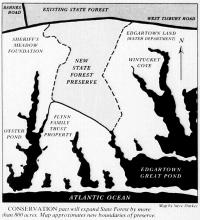The day was cold and clear at the old John Hoft Farm. Pale grasses danced in the wind buffeting the pasture, and nearby ponds were alive with wavelets. Gathered by the farmhouse were more than two dozen Islanders, walkers ready for a tour of this historic property off Lambert’s Cove Road.
As an outdoor treat on the first Sunday of each winter month, the Vineyard Conservation Society holds nature walks at select sites around the Island. The Hoft Farm was a grand setting for last weekend’s excursion, with its 75 acres of wetlands, woods and uplands illuminated by the afternoon sunlight.
Purchased in 1997 by The Nature Conservancy, the century-old farm is a field station for the research and conservation of local plant and animal species. Sharing his knowledge of the property’s natural history, ecologist Bruce Hammond guided the party around a network of roads and ancient ways.
“My guess is all these pitch pines here grew up this century,” he said as the group paused in a grove overlooking a broad meadow. “Pitch pines need soil rich in minerals, so my guess is they seeded into a farm field or pasture. This should gradually convert to a mixed forest.”
Indeed, the Hoft property spent many decades as an active farm, with cattle, sheep, pigs and chickens living next to vegetable patches and a cranberry bog. Long before it assumed that role in the mid-nineteenth century, the land was farmed and managed by Wampanoags.
“This property has been heavily modified,” Mr. Hammond said. “The issue for us is that with a property like this, The Nature Conservancy is involved in identifying what species should be here without human interference, and restoring them. But there are species here that came to depend on the farm landscape. A tricky question with conservation is finding out what you are trying to go back to.”
Connected by creeks and underwater streams, ponds and bogs are found throughout the site’s lowland areas. Much of this property and the adjoining 22 acres adjacent to the Wakeman Conservation Center was once a dense swamp, the product of groundwater pooling above the surface. As agricultural activities increased, stone dams were built to help the water drain into more confined spots.
As people strolled through the meadow, Mr. Hammond pointed out how a blend of native and foreign plant species make up the field and its surroundings. This phenomenon is not peculiar to the Hoft Farm; mixed vegetation is common to many of the Vineyard’s natural places.
Mr. Hammond thinks this is due to a change in the Island’s life cycle over the past 100 years. One thing that used to be commonplace in the local wilderness is practically missing today: fire.
“Fire is a big part of the Island’s existence,” he said. “The Vineyard was only formed as an Island by rising sea levels 8,000 years ago, and Native Americans have probably been in the area as long as 9,000 years. They made use of fire to take care of their land. More charcoal has been discovered here from prior to European settlement than after.
“We think they have been burning around here longer than the Island has been in existence. Most of the natural communities here depended on fire. Around 1900, we started suppressing fires, and going from a landscape that was burned a lot to one that is never burned is a huge ecological change. Fire is a key ecological process here that has been suspended for 100 years.”
The Nature Conservancy is considering a controlled burn of some of the Hoft Farm’s pastures, to set the conditions for the return of certain native plants.
“We’re trying to figure out what those plant communities were, and how big an area they occupied,” Mr. Hammond said. “The prairie species here are struggling for survival. The areas of native grassland are very small. We’re still debating what to do with this property in terms of the fields.”






Comments